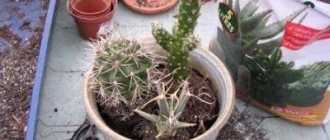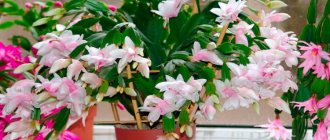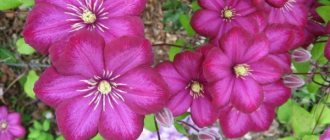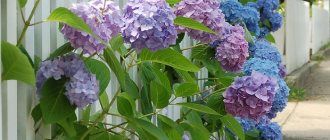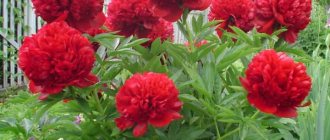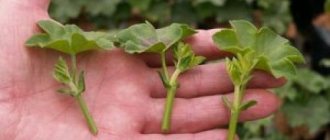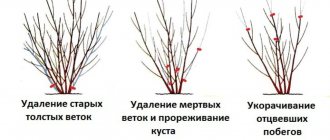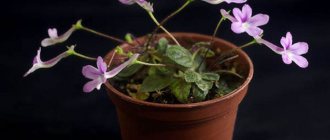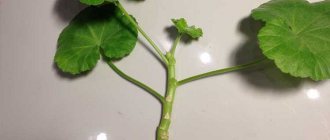The main methods of vegetative propagation of dendrobium
Vegetative methods of propagation using parts of the mother plant are called vegetative. For dendrobium orchids there are three such methods:
| Way | Description | Efficiency |
| Detkovaniye | On mature shoots-pseudobulbs of dendrobium, under certain conditions, children can be formed - young offspring that have their own root system and are capable of taking root and developing when separated from the mother plant. | The survival rate of dendrobium children after separation is excellent. Flowering of rooted children can occur within the first year after planting. |
| Cuttings | Cuttings are made from old pseudobulbs and placed in a greenhouse. After a few weeks, they get babies and plant them in a pot. | The survival rate of children obtained from cuttings is good. However, the cutting process itself is lengthy and is not always successful. |
| Dividing the bush | With strong growth of dendrobium, the bush is divided along the rhizome into equal parts, in each of which several pseudobulbs remain. | The survival rate of the divisions is excellent. Flowering can occur within a few weeks after division. |
Thus, any method of propagating these orchids can give a positive result. Therefore, the choice will depend only on the circumstances. If a dendrobium variety is prone to abundant baby production, there is little point in cutting cuttings. If the orchid is reluctant to bear children, you can try cutting it. Dividing the bush is suitable for old adult specimens.
Important! Propagation of dendrobium by dividing the bush can also be considered rejuvenation. Usually, both divisions, after being freed from dead parts, quickly begin the growing season.
Dendrobiums propagated vegetatively bloom quickly enough. On separated children, the first flowering is not very abundant, but as new growths appear, its quality increases.
How to replant this type of orchid?
Despite the fact that an exotic plant easily adapts to new conditions, its replanting should be done with great care and only at the right time. This is due to a number of reasons.
Main reasons
It will take some time for the orchid to get used to the new soil and climate. Often, stress associated with transplantation leads to growth cessation, flowering and full functioning of the plant. In this regard, dendrobium is transplanted only when necessary .
The orchid root system is characterized by rapid development, as a result of which the root processes intertwine not only with each other, but also with the elements of the soil. Immediately after the roots grow, peculiar thickenings (bulbs) are formed, in which moisture and nutrients accumulate. This indicates that the orchid needs to be prepared for transplantation.
And also the main reasons for this procedure are the following factors:
- the occurrence of a particular disease;
- oxidation and depletion of the soil, changes in its structure, as a result of which moisture ceases to be retained;
- The container is too small, not allowing the root system to be located freely and allow the required amount of air to pass through.
In addition, replanting is required in case of future propagation of the plant.
Important! Experts recommend replanting the dendrobium orchid once every 2-3 years; the procedure should be performed only after flowering has ended.
Typically, exotic plants begin to grow dynamically in April and May, so it is necessary to replant the flower before new roots form, thereby preventing their injury.
Selection of capacity
To grow dendrobium, you can use two types of plastic pots: transparent and opaque.
For flower lovers who have not dealt with orchids, it is recommended to purchase a transparent container for the first plant , which allows you to monitor the condition of the root system and the degree of drying of the substrate. After the principle of caring for exotic plants becomes clear, the plant can be kept in an opaque pot.
If orchids are grown as block crops, you need to provide them with baskets made of wood or plastic. And also for this purpose they use tree bark peels or plastic mesh. Pots must be equipped with drainage holes.
Important! It is not recommended to plant flowers in plastic containers made from cut-off bottles, since such options have poor drainage and overly soft walls, contact with which can disturb the root system.
To replant, you need to select a pot with a diameter 2-3 cm larger than the previous one. It is recommended to give preference to products made of plastic, since the roots of the plant have the ability to stick to the walls of the ceramic, which is why they are damaged when removed from the container.
A pot for dendrobium should have a classic shape, in which the diameter of the bottom is 1-2 cm smaller than the diameter of its upper part. Cast iron containers are not recommended for growing orchids, since when replanting it is impossible to remove the plant from them without causing harm to it.
What kind of soil is needed?
Indoor species of dendrobium belong to epiphytes - specimens that grow on other plants or are permanently attached to them.
Therefore, the best substrate option for them is tree bark. Any type of it is suitable for full growth and development, but it is best if it is taken from a pine tree, since this type will become a reliable support for the roots of the dendrobium. In addition to the bark, you can add a little charcoal. Of the soils purchased at a flower shop, the most popular are the following:
- Aurica Gardens. Substrate specifically designed for epiphytes. It features optimal air and moisture permeability, which is important for the root system of dendrobium.
- Bio effect. The soil contains environmentally friendly angora pine bark. Throughout its use, the required level of acid-base balance is maintained in the substrate.
- Biomaster. The soil is made from the bark of Scots pine grown in Nizhny Novgorod. The packaging of the substrate is a transparent bag, which makes it possible to examine its contents.
When making your own soil for dendrobium, you will need the following components:
- drainage - clay shards or small pebbles;
- moss is a necessary element that maintains an optimal level of humidity;
- flat foam particles – contribute to good breathability of the substrate;
- large bark - intended for laying out the bottom layer of drainage;
- fine pine bark - used to prepare the main soil mixture.
Important! It is permissible to take bark for the substrate only from healthy trees that are not damaged by harmful microorganisms and insects.
Transplantation times for orchids that bloom at different times
Transplanting an exotic plant is allowed no earlier than a year after its acquisition , since such a procedure is accompanied by great stress for the flower.
Transplantation can be done only after the dendrobium stops blooming and enters the phase of intensive growth; it is not recommended to carry out such an event when the exotic plant is at rest.
In addition, replanting will be relevant before plant propagation . Typically, such procedures are carried out in the spring: in April and May. It is best to do this before new roots form, which will prevent injury to them.
Dendrobiums that bloom in autumn need to be replanted before new leaves, buds and shoots appear. The procedure is unacceptable during the period of rest of the epiphyte.
How to move it into a pot: step-by-step waddle technology
Most often, the orchid is transplanted into a larger container due to the active growth of the root system. Provided the roots are healthy and the soil is not depleted, a transshipment method is used, which includes several steps:
- in order to soften the soil, it is pre-watered;
- the specimen along with the lump of soil is carefully removed from the container;
- carefully remove damaged and dead shoots;
- renew the old soil by adding a fertile layer and crushed charcoal, which has disinfectant properties;
- place the plant along with the updated soil in a new pot equipped with drainage holes;
- provide a high level of humidity in the room.
Important! When transplanting dendrobium into a container with a larger volume, adaptation occurs much faster.
Method 1: separating the children from the mother plant and planting
This method of reproduction is the simplest. The main thing in this case is to separate the baby from the mother plant as carefully as possible. The step-by-step procedure is as follows:
- sharp scissors with thin blades are wiped with a cotton swab moistened with alcohol;
- the blades of the scissors are carefully inserted under the base of the child, and the cut is made;
- cuts on the mother plant and on the baby are treated with green tea, cinnamon or crushed activated carbon;
- The baby is placed in a prepared pot or glass with holes, and its roots are sprinkled with substrate.
It is very important to wait for the baby to develop its own roots before separating. There should be at least 2 of them, about 5 cm long. Such an offspring will easily take root in a separate glass.
Tip #1. Experienced gardeners plant baby dendrobiums in a dry substrate. The first watering is carried out only on days 3-5. During this time, the cut has time to heal well, and there are no problems with rotting of the root neck of the baby.
Some orchid lovers plant several children at the same time in a common pot, tying them in a bunch. This is done to make the first flowering more decorative. As the plants grow, they are divided into separate pots.
How to propagate?
Each reproduction method has its own technology, compliance with which will be the key to a positive result.
Dividing the bush
Dividing the dendrobium into 2 or more specimens is considered an effective method of propagation. The main condition is that the plant has at least 6 shoots.
Step by step process:
- the orchid is removed from the pot, the old substrate is removed;
- straighten the roots, cut off dry ones;
- determine the division sites so that for each part there are 2 pseudobulbs and the same number of young shoots;
- wounds are sterilized;
- planted in pre-prepared pots in dry soil;
- the next day, the flowers are watered and normal growing conditions are provided.
Cuttings
The peculiarity of dendrobium as a sympodial species of orchid is that the bush grows horizontally. As a result, new shoots are formed, and old ones lose leaves and reduce the decorative effect of the flower. But they are the ones that are suitable for the cutting method.
Stages of work:
- The shoot is separated at the root with a sterile knife from the mother bush.
- Cut into pieces of 10 cm.
- Wounds are treated with charcoal, cinnamon, and hydrogen peroxide.
- Sphagnum moss is placed in the container and moistened.
- The cuttings are laid out on it, covered with a lid or wrapped in a transparent plastic bag and secured.
- Keep at a temperature of +20-25 °C, ventilate once a day.
- If desired, spray 1-2 times with Epin solution.
- After 2-3 weeks, roots will begin to appear. Young plants are transplanted into ordinary pots.
When using the cutting method, dendrobium blooms for 2-3 years.
If germinated cuttings are exposed to low temperatures (from +15 °C and below), then flower stalks will grow from the buds instead of children. Such plants are not suitable as planting material and are thrown away.
Children
This method is considered the most popular and simplest. To stimulate the development of children, do the following:
- reduce watering;
- increase the temperature to +30 °C;
- humidity is increased to 70%;
- fertilize with fertilizer containing nitrogen.
A pseudobulb will appear from the awakening bud. When 4-5 leaves appear, 2-3 roots appear and the length of the shoot reaches 5-8 cm, the children are ready for planting.
Further actions:
- a sharp knife or blade is disinfected with alcohol;
- cut off the pseudobulb under its base;
- wounds are treated with activated carbon, cinnamon or brilliant green;
- the babies are left to dry for 1 day;
- prepare a small pot with a fine fraction substrate and plant the shoot there.
When planting, the growing point is not buried.
Water for the first time on days 2-4. During denrobium rooting, humidity is maintained at 70-80%, daylight hours are increased to 14 hours a day. The optimal temperature is +22-25 °C.
If children do not have roots, then it makes sense to stimulate their education.
Growing process:
- the seedling glass is filled with moss and watered;
- plant the shoot;
- place in a warm, illuminated place, spray periodically;
- When 3-4 roots are formed, they are planted in a pot using standard technology.
Children should not be placed in a glass of water. This will cause the plant to rot.
Method 2: dendrobium orchid cuttings
Dendrobium orchids have one small drawback. Being sympodial orchids, they grow in width and form new pseudobulb shoots. At the same time, the old ones gradually age and lose leaves. “Bald” pseudobulbs reduce the decorative value of the bush, so gardeners try to cut them out. It is these cut out old shoots that become cuttings.
In order to provoke the appearance of children on cuttings, it is necessary to prepare a greenhouse:
- take a plastic container with a lid;
- lay a thick layer of damp sphagnum moss in it;
- make several small ventilation holes in the lid.
After this, the cuttings are laid on top of the moss, sprayed with Epin-Extra solution and covered with a lid. The greenhouse is installed in a warm, bright place and ventilated daily.
The awakening of the kidneys and the appearance of children is a long process. For 3-6 months, you will have to take care of the greenhouse every day, monitor the temperature, lighting and humidity, and prevent mold from cuttings.
When the babies finally appear, you need to wait for their roots to form, and then separate them from the cuttings. Planting of offspring grown in this way is done in the same way as those obtained directly from the mother plant.
Separation of the baby from the cutting is carried out in the same way as during normal propagation by babying - using sharp scissors.
Care at home
There are several types of dendrobium orchids, each with individual preferences. However, they also have common requirements - diffused and bright light, excluding direct exposure to infrared rays, as well as the absence of drafts.
Temperature
The optimal temperature for growing orchids in spring and summer is from +20 to +26°C. Good flowering is facilitated by daily temperature changes, varying between 6-7°C.
That is, during the day the temperature should be slightly higher than at night. In autumn and winter, the air temperature for keeping dendrobium should be reduced to +13-18 °C.
Important! It is not permissible to lower the temperature to + 12 °C or lower, since the plant does not tolerate cold and drafts.
Lighting and Humidity
Dendrobium prefers diffused but bright light.
In autumn and winter, it is recommended to keep the plant on windows facing south, and in spring and summer - to the east and west. This is due to the exotic’s intolerance to the scorching rays of the sun. The duration of daylight for this type of orchid is approximately 12 hours. In winter, it is recommended to provide artificial lighting in the room with the flower. For this purpose, it is best to use a phytolamp.
On warm days, it is advisable to take the dendrobium out into the fresh air, placing it in the shade.
In hot weather, it is necessary to periodically humidify the air in the room with the orchid. In addition, pots with plants can be placed on a tray of water or sprayed daily. The best time for this procedure is early morning or late evening, when wet drops cannot cause burns.
Watering
Watering is recommended to be done by immersion or surface method. To do this, use boiled water at room temperature. This procedure is required only when the soil is dry.
Important! Stagnation of moisture in a pot with dendrobium will lead to the death of the plant.
Feeding
You should start feeding exotics in April and do this until September. Fertilizer should be applied after watering, using liquid formulations intended specifically for orchids.
The concentration of fertilizers when feeding dendrobium should be 2 times weaker than indicated on the packaging.
During the growth and maturation of formed pseudobulbs, flower growers recommend using complex mineral supplements, and during the flowering period - compositions containing large amounts of potassium and phosphorus. Fertilizing flowering orchids with nitrogen should be minimal.
If you follow all recommendations for propagation and further maintenance of exotic dendrobium, you can obtain high-quality and healthy specimens. In the future, these orchids will delight the gardener for many years.
Method 3: propagation of dendrobium by dividing the bush
Dividing an old bush is the most effective way to propagate dendrobium. It has only one drawback - as a result, you can only get two young specimens. However, they will already be adults, completely independent, will quickly begin to bloom and will not require special care.
If a dendrobium bush has six or more shoots, it can be divided. This is done like this:
- the orchid is removed from the pot and freed from the old substrate;
- dry parts of the roots are removed with scissors;
- the plant is cut along the rhizome into two equal parts;
- The sections are sprinkled with ground cinnamon.
Next, the divisions are placed in pots and sprinkled with dry substrate. They are kept without watering for a week, after which normal care can be resumed.
Processing and drying of sections on the rhizome is strictly necessary. If this is not done, the process of rotting of the orchid's root system may begin.
What you are not allowed to do
Do not pick flower stalks before transplanting, and never in general. The orchid itself will decide at what point to get rid of them. If the need for the arrow disappears, then it simply dries out.
Also, dendrobium should not be given fertilizers - they are needed only during the growing season. Spraying with a weak solution of regular glucose will not harm the orchid.
You should not allow the roots to become intertwined - this will make it much more difficult for you next time to move the flower to a new pot.
Caring for planted dendrobium children
If there are usually no problems with divided bushes bearing fully mature shoots, then the children will require special supervision at first. Their care must be organized in accordance with the following conditions:
| Condition | Peculiarities |
| Temperature | Children cut from the mother plant can immediately be kept in the usual temperature range - from +17 to +240C. Scions obtained from cuttings will require hardening. For them, the air temperature must be lowered gradually. |
| Humidity | Air humidity should be between 50-70%. The soil should not be over-moistened. Children need to be watered so that the substrate remains slightly moist, but does not become waterlogged. It is also impossible to overdry - in dry bark the growth of the root system will not go well. |
| Light | At first, children need to be slightly shaded from the sun. It is better to install artificial light or place them on a western window. |
Feeding should begin no earlier than the baby shows the main sign of rooting - active root growth. Fertilizers are used in half the dose.
It is better to plant children in small containers. In them it will be easier for them to master the volume of the substrate, and rooting will take place faster.
An easy way to transplant
The peculiarity of the denrobium orchid is that its root system grows quite quickly. At times, you need to move your indoor flower into a larger pot more often than other orchid varieties. If the flower is healthy, the roots are not damaged, and the substrate is still good, then “transshipment” is most often used:
- Soak the soil mixture and disassemble it into smaller parts.
- Clean the roots from damaged dead shoots.
- Gently loosen the old soil and renew it by adding some fresh substrate.
- For disinfection purposes, place small pieces of charcoal into the soil mixture.
This method allows you to partially preserve the usual habitat when transplanting dendrobium. Adaptation with this method will not be so painful. In fact, the houseplant is simply moved into a larger pot. Flower growers advise combining such a transplant with orchid propagation.
The opinion of flower growers on the vegetative propagation of dendrobiums
If we put propagation by division aside as a special case, we can compare the effectiveness of hatching and cuttings of dendrobiums. Flower growers who have tried both methods have their own opinion on this matter:
“I have several dendrobiums in my collection, so after pruning there are always a lot of shoots left that are a pity to throw away. Even though I get enough babies directly on the trunks, I still always try to plant cuttings for germination. Comparing the methods, I can say that the babies from the trunks themselves are stronger and more durable than those from the cuttings. In any case, for me they take root in 99% of cases, and from cuttings - only half. Perhaps the problem is limited nutrition (what will they get out of the cuttings?) and greenhouse conditions. As soon as the babies come out of the container into the air, they immediately begin to slow down and fall out” (Svetlana, Jurmala).
Features of care after flowering
A Dendrobium nobile flower that has stopped blooming is gradually stopped being watered. The peduncle is cut off, and the pot with the plant is transferred to a cool and dark place. During this period, he enters a resting phase. In such conditions, it will rest and prepare for a new flowering.
Under natural conditions, such a flower does not have a resting phase - it constantly grows leaves, shoots or becomes overgrown with children. In our latitudes in the winter season the days are short (it gets light and dark early). Therefore, the plant may go into hibernation and stop growing altogether. To prevent this, he needs to be provided with full daylight hours. For this you will need artificial lighting. The lamp is installed at a distance of 0.5 m from the flowerpot and turned on in the morning and evening hours.
Expert advice on dendrobium cuttings
Indeed, offspring from cuttings are generally weaker than those grown by the “mother”. To reduce the percentage of lunges after transplanting into pots, you need to cover them with a transparent cap for some time, gradually accustoming them to unstable temperature conditions.
When cutting cuttings, you may encounter another interesting nuance, which expert flower growers write about:
“The container with cuttings should not be refrigerated or kept at a low temperature. It's not just about the risk of mold. Even if the conditions are sterile, at a temperature of +150C and below, not babies, but flower stalks may emerge from the buds of the cuttings. Of course, such “blooming” will not be complete, and the cutting will have to be thrown away. Therefore, containers must be kept warm – from +20 to +250C.”
Yu. Korbun, gardener, landscape designer
Which pot to choose?
- Dendrobium orchids must be planted in special blocks, orchid baskets or pots.
- Pots should be chosen from clay or plastic. Clay pots are preferable because they can provide the plant with the necessary stability from tipping over.
- It is recommended to choose the size of the pot in accordance with the size of the root system. The roots should fit comfortably into the pot.
When lowering the roots into the pot, you need to leave about 2 cm of free space around the edges . Be sure to place drainage at the bottom of the pot. Pebbles, expanded clay or polystyrene can serve as drainage. The drainage layer should be at least 3 centimeters.
The best and new varieties
Currently, the dendrobium nobile orchid has several decorative flowering varieties that have become very popular among gardeners:
- Kumiko. This is a hybrid species, about 12-13 cm high. The leaves are leathery, dark green in color, and the trunks are pseudo-shaped. There are up to 10 flowers on one peduncle. The petals are snow-white with a pale pink edge. With good care, it blooms profusely and for a long time (about 12 weeks).
- Irene smiley. A hybrid plant with fleshy pseudobulb stems and thick leathery foliage. The height of the flower is about 50 cm. Several flower buds are formed on each flower branch. The flowers are white-lilac, the throat is yellow. They thin out a pleasant aroma. It blooms once a year, duration – 12 weeks.
- Apollo. Tall hybrid, reaching 70 cm in height. The leaves are dense, dark green, leathery. The pseudobulb trunks are fleshy. It blooms profusely with white flowers with a yellow throat. Produces several flower stalks. About 10 flower buds are formed on one flower branch. Flowering duration is 10-12 weeks. Blooms once a year.
- Orange or orange Tall hybrid plant - 55 cm in height. With good care, it produces up to 3 peduncles. The flowers are yellow or orange. Flowering occurs once a year and lasts 8-10 weeks.
- Noble. One of the most beautiful exotic species with white flowers and purple edging on the petals. The pseudobulb trunks are massive, the leaves are green and leathery. Plant height is 50-55 cm. Produces from 1 to 3 peduncles. With good care it can bloom 2-3 times a year.
Detailed description and photo
Dendrobium nobile (Dendrobium nobile) or Dendrobium noble is a natural species of the genus Dendrobium from the Orchidaceae family.
From the history
Habitat: high mountain forests of Southeast and South Asia. The first Dendrobium was described by the Swedish botanist Olaf Schwartz. And in 1836, Europe learned about a new species that was found in India. For its pleasant aroma and spectacular flowering, it was given the specific epithet “nobile” - from the Latin noble .
Currently, the natural species is on the list of protected plants (Appendix II of the CITES Convention). For 120 years, many hybrids have been created on its basis, which are grown as a potted crop. Therefore, in the pedigrees of all store-bought Nobile orchids there is only a minimal percentage of the natural species. And the higher it is, the more expensive the plant.
What does Dendrobium nobile look like?
Nobile has the appearance of a tall bush with one or several stems . In the wild, the height reaches a meter, and at home it is about 60 cm.
The stem is elongated pseudobulbs that are divided into segments. Erect, fleshy, glossy, deviating downward over time. At the attachment points of the leaves there are buds that develop into peduncles or sprouts (babies). Every 2-4 years the stems lose leaves, turn yellow and die.
Flowers of different hybrids can be collected in inflorescences of up to 4 pieces each . Flower diameter is from 5 to 10 cm. Petals have a waxy texture. Most often two-colored: white at the base and with lilac, violet, red or orange ends. There are also plain ones: white, pale pink, yellow. The lip is ovoid, with a round purple or yellow spot.
The leaves are linear-lanceolate, light green, located along the length of the stem.
How is it different from other orchids?
Dendrobium nobile forms flower stalks not only at the top of the pseudobulb, but along its entire length.
The number of flowers reaches 70 pieces. Cut flowers remain fresh for about 10 days.

